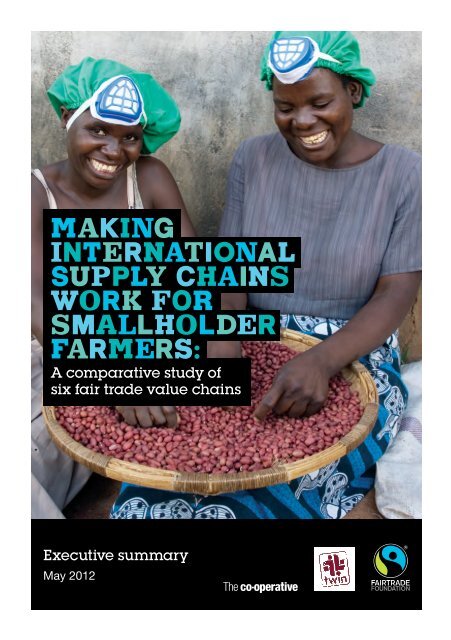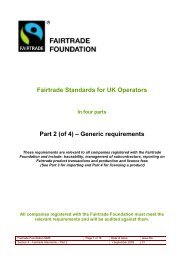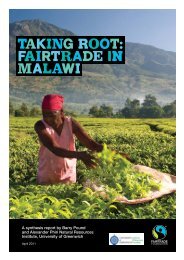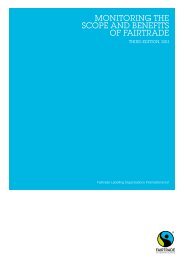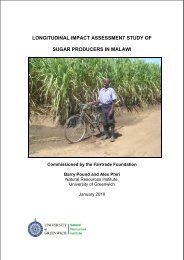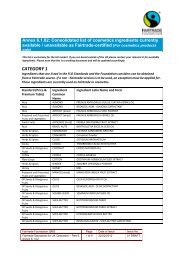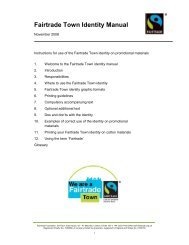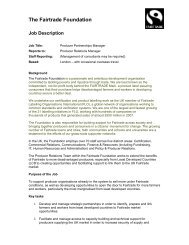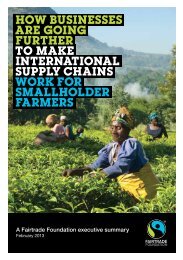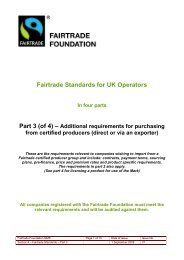Making supply chains work for smallholder farmers - The Fairtrade ...
Making supply chains work for smallholder farmers - The Fairtrade ...
Making supply chains work for smallholder farmers - The Fairtrade ...
Create successful ePaper yourself
Turn your PDF publications into a flip-book with our unique Google optimized e-Paper software.
<strong>Making</strong><br />
international<br />
<strong>supply</strong> <strong>chains</strong><br />
<strong>work</strong> <strong>for</strong><br />
<strong>smallholder</strong><br />
<strong>farmers</strong>:<br />
A comparative study of<br />
six fair trade value <strong>chains</strong><br />
Executive summary<br />
May 2012
EXECUTIVe<br />
SUMMARY<br />
This report provides an analysis<br />
and evaluation of how specific<br />
business practices facilitate <strong>smallholder</strong><br />
producer development and<br />
empowerment in <strong>Fairtrade</strong> <strong>supply</strong><br />
<strong>chains</strong>. This research comes at a critical<br />
moment in time owing to a renewed<br />
interest from the donor community<br />
and the private sector into the central<br />
role that <strong>smallholder</strong>s play in driving<br />
rural development and also ensuring<br />
the sustainability of future global<br />
<strong>supply</strong> <strong>chains</strong>.<br />
Six farmer organisations across three<br />
commodities (cocoa, tea and nuts)<br />
were chosen to represent different<br />
business models within the <strong>Fairtrade</strong><br />
movement. Researchers used focus<br />
groups and semi-structured interviews<br />
with a variety of stakeholders to<br />
develop a case study <strong>for</strong> each of<br />
the selected farmer organisations.<br />
<strong>The</strong> in<strong>for</strong>mation collected was then<br />
analysed using a frame<strong>work</strong> <strong>for</strong><br />
understanding the key indicators<br />
of producer empowerment and<br />
development. In this process five broad<br />
elements of the <strong>smallholder</strong> <strong>supply</strong><br />
chain relationship were investigated<br />
and then presented in a radar<br />
diagram set out in figure 1.<br />
Figure 1:<br />
Five elements of <strong>smallholder</strong> <strong>supply</strong> chain relationships<br />
Built Capacity<br />
Influence on<br />
price and terms<br />
Net Returns<br />
Supply chain<br />
coordination<br />
Control over<br />
and % of the<br />
value chain<br />
<strong>The</strong> five broad elements of the radar diagram<br />
are as follows:<br />
• Net returns: the amount that the <strong>smallholder</strong>s<br />
receive <strong>for</strong> their produce and its significance<br />
to their livelihood. This includes <strong>smallholder</strong>s’<br />
perception of whether they are ‘hanging in’,<br />
‘stepping up’ or ‘stepping out’.<br />
• Control over and % of the value chain: a<br />
combination of <strong>smallholder</strong>s’ perceptions<br />
of their influence on the <strong>supply</strong> chain and<br />
the percentage of the final retail price that<br />
<strong>smallholder</strong>s receive.<br />
• Supply chain coordination: the level of<br />
transparency and the extent to which<br />
in<strong>for</strong>mation is exchanged between stakeholders<br />
within the value chain.<br />
• Influence on price and terms: <strong>smallholder</strong>s’<br />
perception of their ability to influence the price<br />
they receive <strong>for</strong> their produce.<br />
• Built capacity: the extent to which trading<br />
partners directly contribute to enhancing the<br />
long-term capacity of the <strong>smallholder</strong>s.
Research findings show that <strong>smallholder</strong> <strong>supply</strong><br />
chain relationships are not uni<strong>for</strong>m and there is<br />
a great deal of variability, even between farmer<br />
organisations based in the same country dealing<br />
in the same commodity.<br />
A model of change is presented that delineates<br />
the stages that farmer organisations go through<br />
on their path towards sustainability and examples<br />
of best practice are given that will assist in a<br />
smooth transition along this path. Analysis of<br />
findings confirms the complexity of empowerment<br />
and development and the fact that there is no<br />
single <strong>for</strong>mula to achieving either. <strong>The</strong>y do,<br />
however, provide a number of interesting insights<br />
on the nature of the trading relationship.<br />
<strong>The</strong> size of net returns varied significantly across<br />
the different case studies and between different<br />
groups of members and types of activities. What is<br />
noteworthy is that price and the ability to influence<br />
it seemed to play a much less significant role in<br />
explaining relative returns than productivity.<br />
<strong>The</strong> case studies also highlighted the importance<br />
of the timing of returns both in tea and groundnuts.<br />
This is not surprising given the important matter of<br />
access to finance in the context of rural economies<br />
where seasonality looms large.<br />
A lack of transparency means that producers can<br />
struggle to access the actual prices and margins<br />
linking their payment to downstream sales.<br />
Very little in<strong>for</strong>mation regarding the end use of<br />
the product appears to be relayed to <strong>farmers</strong>.<br />
Where it does, an immense sense of pride and<br />
accomplishment can be the result.<br />
Farmers in many of the organisations identified<br />
capacity building services provided or funded by<br />
buyers as a key reason <strong>for</strong> trading with them. <strong>The</strong><br />
nature of relationships with buyers is a key theme<br />
in most of the case studies. Relationships between<br />
farmer organisations and buyers are often very<br />
positive and constructive but there is a sense that<br />
there is a fine line between building their capacity,<br />
in an empowering way, and ‘replacing capacity’,<br />
in a way that disempowers.<br />
Analysis of these findings has led to the<br />
following conclusions.<br />
At the farmer organisation level pre-finance is a<br />
key element in determining whether co-operatives<br />
are able to operate on the same playing field as<br />
better resourced traders and processors. Access<br />
to finance at the appropriate time can also play an<br />
important role in freeing up cash <strong>for</strong> <strong>farmers</strong> at the<br />
household level.<br />
Underlying tensions between retaining cash<br />
to invest in the business and the distribution of<br />
profits to <strong>farmers</strong> to supplement their income also<br />
emerges as a key constraint to the development<br />
of sustainable farmer organisations. If cash is to<br />
be distributed to <strong>farmers</strong> then the timing of this<br />
transfer should be carefully considered.<br />
When taking into account the appropriate levels of<br />
support <strong>for</strong> farmer organisations it is proposed that<br />
the need to provide intensive support is balanced<br />
with the dangers of creating an unhealthy<br />
dependency. It is recommended that organisations<br />
consider how to encourage autonomous farmer<br />
organisations rather than long term adoptive<br />
relationships. A question is also raised as to<br />
whether it is right to expect <strong>Fairtrade</strong> and private<br />
sector players to engage at the level of household<br />
decision-making on how income is to be spent.<br />
At the heart of creating more empowering<br />
relationships between buyers and farmer<br />
organisations (and between farmer organisations<br />
and <strong>farmers</strong>) is a shift in attitude and perception.<br />
To move <strong>for</strong>ward it is important that buyers<br />
perceive <strong>farmers</strong> as active partners and not<br />
passive beneficiaries. It is also thought that<br />
buyers and traders need to move beyond simply<br />
complying with <strong>Fairtrade</strong> standards if they are<br />
to support improvements across the range<br />
of indicators described.<br />
Based upon these conclusions a set of<br />
recommendations <strong>for</strong> buyers of businesses<br />
engaging with <strong>smallholder</strong> <strong>supply</strong> <strong>chains</strong> are<br />
made. A number of future research questions<br />
highlighting issues that emerge from the research<br />
and require further investigation are also<br />
presented.<br />
See over <strong>for</strong> recommendations
Recommendations<br />
<strong>for</strong> buyers<br />
<strong>The</strong> research and resulting conclusions suggest<br />
a number of recommendations <strong>for</strong> business<br />
engaging with <strong>smallholder</strong> value <strong>chains</strong>:<br />
Relationships<br />
• Develop and regularly review MOU between<br />
business and farmer organisation to clarify<br />
expectations of relationship<br />
• Where possible articulate long term<br />
commitment to relationship<br />
• Consider the timing of cash payments,<br />
especially in light of seasonality, and how<br />
availability or lack of finance also impacts<br />
on households<br />
Autonomy<br />
• Set targets over time <strong>for</strong> farmer organisations<br />
to sell to other buyers (jointly commit to<br />
reduce direct dependency over time)<br />
• Build administrative capacity of farmer<br />
organisations not just of <strong>farmers</strong>, e.g. when<br />
seeking to enhance farmer access to inputs<br />
support the farmer organisation rather than<br />
directly <strong>supply</strong>ing<br />
• Where investment is only attractive with<br />
adoption and with greater control, consider<br />
how to encourage more autonomy and<br />
responsibility over time (e.g. encourage some<br />
‘side-selling’, development of new trading<br />
relationships)<br />
www.fairtrade.org.uk<br />
<strong>Fairtrade</strong> Foundation, 3rd Floor, Ibex House,<br />
42-47 Minories, London EC3N 1DY<br />
Tel: +44 (0)20 7405 5942 Fax: +44 (0)20 7977 0101<br />
Registered Charity No. 1043886. A company limited by guarantee, registered<br />
in England and Wales No. 2733136 Photography credit: Anette Kay<br />
In<strong>for</strong>mation and transparency<br />
• Provide in<strong>for</strong>mation to farmer organisations<br />
on where their produce has ‘gone’ including<br />
in<strong>for</strong>mation on quality with recommended<br />
steps to address any issues<br />
• Provide in<strong>for</strong>mation on markets<br />
• Encourage farmer organisations to provide<br />
transparent in<strong>for</strong>mation on all relevant<br />
transactions to members to encourage<br />
transparency and accountability along the<br />
chain<br />
• Encourage farmer organisations to<br />
communicate effectively with members<br />
• Where physical traceability is not feasible<br />
consider what additional steps are required<br />
to ensure producers have confidence<br />
in transactions and can identify key<br />
downstream customers<br />
Supply chain control<br />
• Connect with producers (invite <strong>farmers</strong> to<br />
meet buyers) and link them to downstream<br />
buyers; use them to build the market<br />
• Respect producer Intellectual Property (IP)<br />
when marketing product but promote the<br />
face and people behind it


